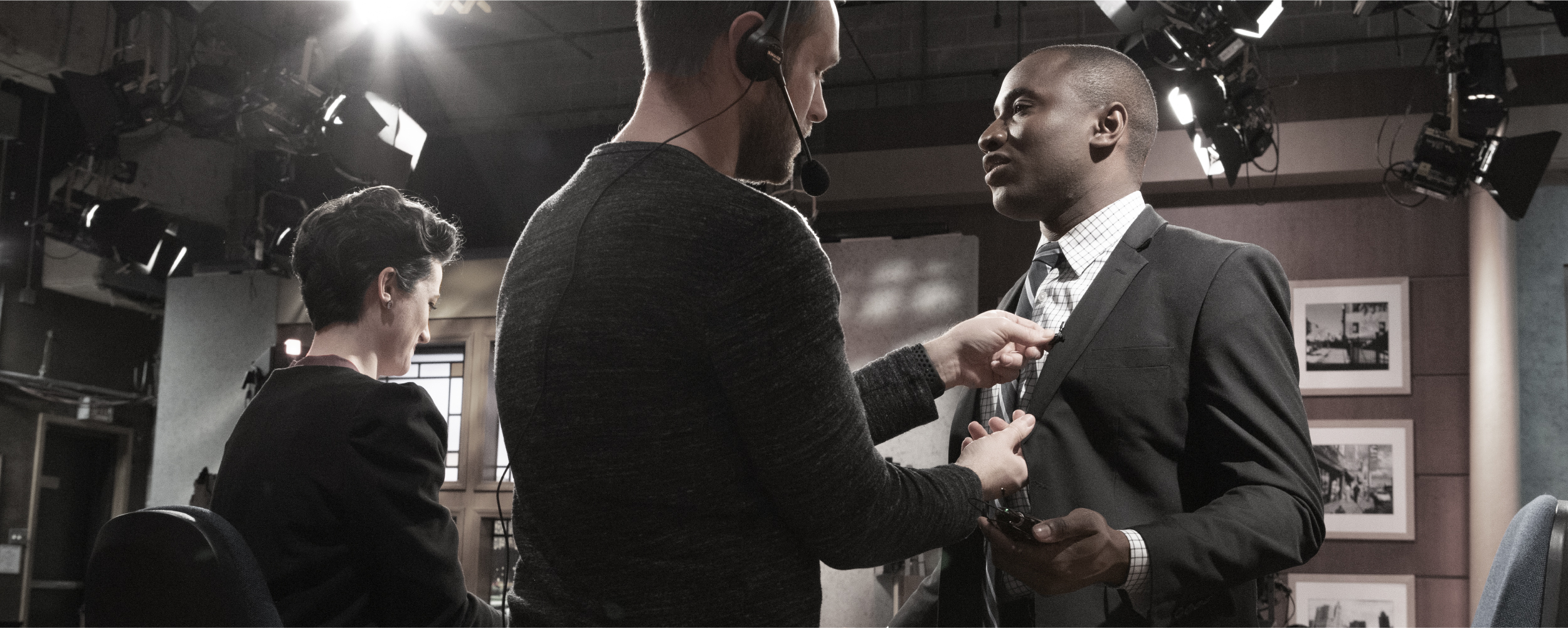Go Hands-Free: Lavalier Vs. Headworn Microphones
Posted by Kylie Bowman - SoundPro on Nov 29th 2022
Estimated Reading Time: 6 Minutes
Lavalier and headworn microphones are excellent audio solutions that give you the ability to walk freely about your space. Portability and hands-free use make lavaliers and headsets popular for broadcast journalism, theaters, houses of worship, and more. Whether it’s your application or personal preference, you’ve determined that portability and hands-free use are important to you in microphone choice. Both headsets and lavaliers can be great, so how do you choose one over the other?
LAVALIER MICROPHONES
Lavalier or lapel microphones are miniature microphones built to capture audio in a practically invisible format that allows the performer to be hands-free and mobile. They traditionally clip to a lapel, or about 5-8” below the mouth.
The lavalier microphone style first came about in the 1950s. Though original designs were bulkier than what we recognize today, the concept was mostly the same.

Lavaliers: Things to Consider
Lavaliers are popular for many reasons, most notably their discreet design and relatively inexpensive cost. Since they are built to clip to a shirt and do not conform to the speaker’s face or head, this allows them to be used by different people without affecting the mic’s performance or long-term durability.
There are some potential downsides to consider before choosing a lavalier microphone. Mic placement of a lavalier is even more critical than most other microphones; incorrect placement creates a greater potential for feedback and room noise, or the chance you won’t hear the performer at all. Sound levels also fluctuate a lot as the speaker’s head turns. For these reasons, it is typically helpful to use lavaliers in situations where the presenters understand how lavaliers work or have worn this mic format before.
Given these considerations, we recommend lavs for professional speaking applications such as broadcast journalism, and in speaking situations where the lavalier format has been popular in the past, such as in houses of worship. Lavaliers are also sometimes found in theater applications, especially in school and community theaters.
Proper Lavalier Wear
The most common way to wear a lav is clipped to the lapel. On clothing without a lapel, this will mean placing the mic slightly above the sternum. Simply use the clip included with most lavalier microphones and attach the microphone to the performer’s clothing.
Another way to wear a lavalier microphone is in the hairline. This is a great option for film, television, and theater applications. Position the lavalier in a hair part so that the microphone capsule rests around the forehead hairline. The lav can become part of the actor’s hairdo to be held in place; otherwise, small rubber bands or tension springs are a good solution.
Can I Convert My Lavalier into a Headworn Mic?
Yes, certain headset mount lavalier mic accessories—such as RØDE’s Lav-Headset—allow you to rig your lav like a headworn mic. This is a budget-friendly compromise if you already have a lav but are debating on whether to upgrade to a headworn mic.
Lavaliers We Love
- The lavaliers from the Shure WL Series are a great option. Affordability meets quality, making these a popular choice for houses of worship and local theaters. Our favorite is the WL185, which has a 130° pickup angle.
- Known for capturing high-quality audio in a lavalier format, the Countryman B3 omnidirectional microphone is available in a variety of connectors, colors, and sensitivities. Ideal for broadcast journalism and other on-camera miking.
- Though incredibly small, even for a lavalier, the Point Source Audio CO-8WL offers the high-performance characteristics associated with larger microphones. This lav, available in different colors and connectors, is popular on Broadway and other stages.

HEADWORN MICROPHONES
Headworn microphones (or headsets) also emphasize hands-free and flexible use. The mic rests close to the mouth, delivering accurate sound without causing a big visual distraction to your audience.
Headworn mics first came to prominence when Janet Jackson wore one on tour in the 1980s. Similar to the evolution of lavaliers, headworn mics have also become substantially less bulky over the years.
Headworn Microphones: Things to Consider
A major plus to headset microphones is they’re easier for sound techs to work with than lavs. Since the mic is placed right next to the mouth (instead of near the lapel) gain before feedback is better, and the audience hears consistent sound levels even as the vocalist’s head moves. These qualities make headworn mics excellent for energetic performers and speakers – some are even built to be durable enough for fitness instructors.
There are a few potential drawbacks that hold people back from purchasing a headset microphone. They tend to be a more expensive option, requiring more of an investment. Headsets are also built to be used only by one person, making this investment even more important to consider. Most headset designs bend slightly to accommodate the person’s head shape; letting multiple people use the mic on different occasions can cause the mic to get bent out of shape and not perform as well. Additionally, headset mics do require a bit more setup and maintenance than lavalier mics.
Given these considerations for headworn mics, we recommend them for any live sound application, but we especially like them for highly mobile performers or speakers.
Proper Headworn Microphone Wear
It can also be considered a benefit of headworn mics that you don’t have to decide how or where to wear them. The construction of headset mics leaves you one option: place it on your head and the mic is in perfect positioning.
Headsets Worth the Hype
- Part of the Shure Microflex series, the MX153 offers exceptional speech clarity and enhanced plosive protection without proximity effect. Available in a variety of different colors, this headset is ideally built for presentations, houses of worship, A/V conferencing, and other live sound reinforcement applications.
- Countryman’s E6i earset delivers beautifully uncolored audio while rejecting surrounding noise and feedback. Available in a variety of different configurations, this is well-suited for any public speaking need.
- The DPA 4066 d:fine CORE headset comes with a loop over both ears and is available in a wide variety of configurations. This high-level headset is perfect for broadcasting, presentations, and professional theaters.
NEXT STEPS
Though lavalier and headworn microphones each have their benefits and drawbacks, there are great options in either style. For assistance picking out a microphone that will be right for your application, contact an Account Manager at info@soundpro.com or 800.203.5611.

Kylie Bowman – Web Content Specialist
A lifelong passion for writing and music made Kylie thrilled to join the SoundPro team in March of 2021. She’s a bottomless pit for books; you can lately find her curled up on the couch with one and a mug of apple cider on the side.

